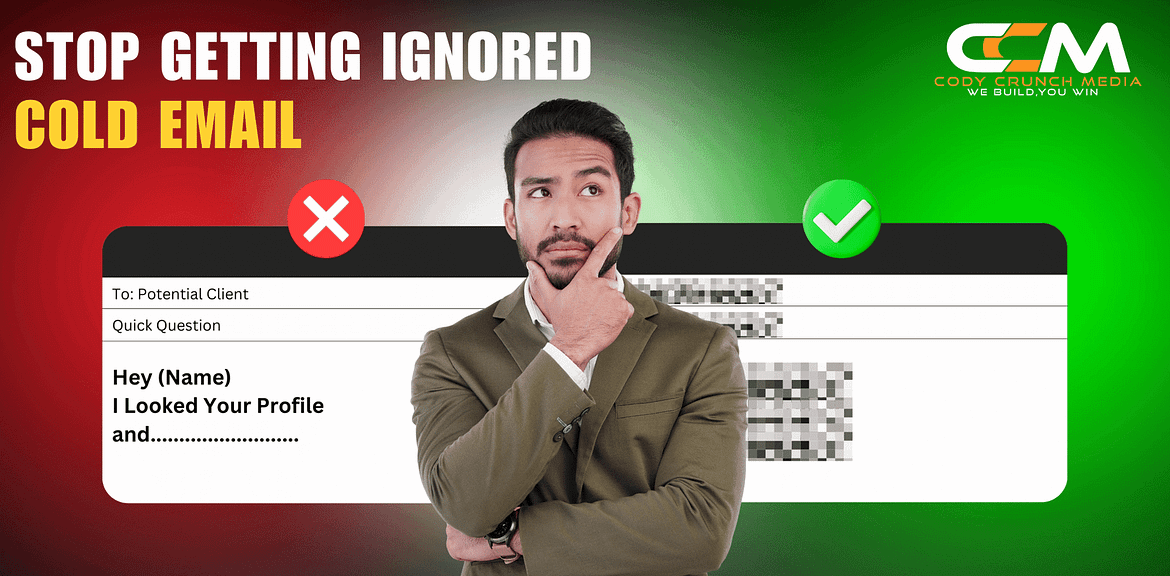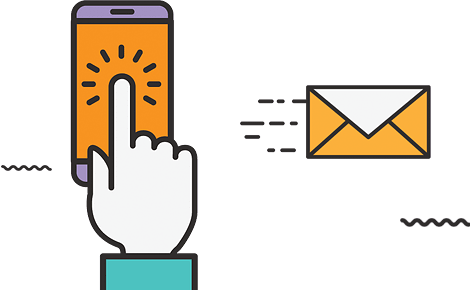Stop Getting Ignored: Proven Cold Email Outreach Strategies That Drive Results in 2025
Cold email outreach is a powerful tool for businesses to connect with potential clients and grow their networks. However, it’s no secret that many attempts to send cold emails fail to deliver the desired results. The reason? Emails that are poorly written, lack personalization, or don’t address the recipient’s needs often end up being ignored—or worse, marked as spam.
But here’s the good news: crafting cold emails that grab attention, spark curiosity, and drive action is not as hard as it seems. You can turn your cold email outreach into a lead-generation machine with the right strategies.
At Cody Crunch Media, we specialize in creating high-converting cold email campaigns that help businesses build meaningful connections and close deals faster. Our proven methods focus on personalization, clear messaging, and a strategic follow-up system, ensuring your emails don’t just get opened—they get replies.
In this ultimate guide, we’ll break down the exact steps you need to:
- Write compelling email copy that resonates with your target audience.
- Avoid common pitfalls that lead to low open and reply rates.
- Leverage Cody Crunch Media’s expertise to take your cold email lead generation to the next level.
Let’s dive in and unlock the secrets to cold outreach success.
Why Cold Emails Are Still Relevant in 2025
You might wonder: “Do people still open cold emails?” The answer is yes—if they’re done right. While social media and messaging apps have grown in popularity, email remains a professional standard for business communication. According to studies:
- Email marketing has the highest ROI of any marketing channel, returning $42 for every $1 spent.
- Cold emails are a direct and personal way to connect with decision-makers.
- Over 4.3 billion people use email daily, making it a universal medium.
However, with inboxes flooded daily, only well-crafted cold email examples stand a chance.
The Foundation of a High-Converting Cold Email
What separates a cold email that gets opened from one that’s ignored? It’s all about the foundation. Every great cold email has four essential elements:
- Relevance: Make it clear why the email is for them. Generic pitches don’t work.
- Clarity: Keep it simple. Complex language or unnecessary details will lose attention.
- Value: What’s in it for them? Offer a solution, insight, or something helpful.
- Actionable CTA: Guide them on what to do next, like replying or scheduling a call.
Let’s explore how to structure these elements for maximum impact.
Anatomy of the Perfect Cold Email
A cold email can be broken down into five parts:
1. Subject Line
The subject line is your first impression. A great subject line creates curiosity and encourages the recipient to open your email.
- Use their name or company name for personalization.
- Keep it under 5-7 words.
- Example: “Quick question for [Company Name].”
2. Opening Sentence
The first sentence needs to hook the reader. Avoid generic lines like “I hope you’re doing well.” Instead, start with:
- A compliment: “I loved your recent post on [topic].”
- A question: “Are you facing [specific challenge]?”
- A personalized observation: “I noticed your company recently [achieved something].”
3. Body
The body of the email is where you deliver your value. Focus on:
- Addressing their pain points.
- Explain how you can help in 1-2 sentences.
- Keeping the tone conversational and easy to read.
4. Call-to-Action (CTA)
Always end with one clear action. Examples:
- “Would you be open to a quick 10-minute call this week?”
- “Let me know if you’d like more details, and I’d be happy to share.”
5. Signature
Keep your signature professional and informative. Include:
- Your full name.
- Your role and company name.
- Contact information.
Common Mistakes to Avoid in Cold Emails
Even well-meaning emails can fail if they include the following mistakes:
- Being Too Generic: Copy-pasting the same email to everyone rarely works.
- Focusing on Yourself: Don’t make the email about your services. Make it about their needs.
- Overloading with Information: Avoid sending long paragraphs. Keep it concise.
- Using Spammy Words: Avoid words like “guarantee,” “free,” or “act now,” which trigger spam filters.
- Skipping Personalization: Addressing someone as “Dear Sir/Madam” or “To Whom It May Concern” is a quick way to be ignored.
Bad vs. Good vs. Great Cold Emails
Bad Email Example:
Subject Line: “Amazing Offer for Your Business!”
Body: “Hi there, I’m [Name] from [Company], and we offer amazing services that can help your business grow. Let me know if you’re interested.”
Why it fails: Generic, self-centered, and no clear value.
Good Email Example:
Subject Line: “Ideas for [Company Name]”
Body: “Hi [Name], I noticed your company is expanding, and I’d love to share ideas on how we can support your growth. Let me know if you’re open to a chat.”
Why it works: Personalized and relevant but lacks a strong hook.
Great Email Example:
Subject Line: “Quick Question for [Name]”
Body:
“Hi [Name],
I saw that [Company] is focused on [specific goal]. We’ve helped companies like yours achieve [specific result] using [specific solution].
Would you be open to a quick 15-minute call this week to explore how we can help?
I am looking forward to hearing your thoughts.
Best,
[Your Name]”
Why it works: Specific, personalized, and action-oriented.
Advanced Tips for Writing Cold Emails That Convert
- Leverage Social Proof: Mention similar companies you’ve helped or highlight notable achievements to build credibility.
- Time Your Emails Wisely: The best times to send cold emails are Tuesday to Thursday, between 9-11 AM or 1-3 PM.
- Use Tools to Personalize at Scale: Tools like Mailshake, Lemlist, and Reply.io can help you create personalized campaigns efficiently.
- Experiment with Video Emails: Adding a short personalized video (using tools like Loom) can dramatically increase response rates.
Mastering the Follow-Up Sequence
Most cold outreach replies come after the second or third email. Persistence is key, but don’t overdo it. A good follow-up sequence includes:
- Email 1: Your initial pitch.
- Follow-Up 1 (Day 2-3): “Just checking in to see if you received my last email.”
- Follow-Up 2 (Day 5-7): Share additional value or insights.
- Follow-Up 3 (Day 10-14): Use humor or a more casual tone, e.g., “I promise this is my last email!”
- Break-Up Email (Day 21+): End with a final offer or resource, e.g., “I understand if now isn’t the right time. Here’s a free resource you might find helpful.”
Tracking and Improving Your Cold Email Campaigns
To improve your results, you need to measure your performance. Track these key metrics:
- Open Rate: Aim for 50-80%.
- Reply Rate: A good rate is 3-5%.
- Bounce Rate: Keep this below 2%.
Conclusion: Cold Emails That Start Conversations
Cold emailing is more than just sending out messages—it’s about creating opportunities and starting conversations. With the right strategies, you can turn cold emails into a powerful tool for building relationships and growing your business.
Start with the tips and cold email examples shared here, test your approach, and keep refining until you find what works best for your audience.
Frequently Asked Questions (FAQ)
1. What is cold email outreach?
Cold email outreach is the practice of sending personalized emails to potential clients or leads who have no prior interaction with your business. The goal is to introduce your products or services, generate interest, and initiate conversations that could lead to business opportunities.
2. How can I send cold emails effectively?
To send cold emails effectively:
- Personalize your subject lines and content.
- Highlight the recipient’s pain points and offer solutions.
- Use clear and actionable CTAs.
- Avoid spammy language and focus on providing value.
3. What makes a good cold email agency?
A good cold email agency focuses on creating personalized, high-converting campaigns. They understand the importance of targeting the right audience, crafting compelling copy, and optimizing open and reply rates. Agencies like Cody Crunch Media specialize in helping businesses achieve measurable results through strategic cold email lead generation.
4. Can you share some examples of cold emails?
Certainly! Here’s a quick example:
Subject Line: “Quick Question for [Name]”
Body:
“Hi [Name],
I noticed [specific challenge/opportunity] for [Company]. We’ve helped similar businesses achieve [specific result] using [specific solution].
Would you be open to a 15-minute call this week to discuss how we can assist you?
Looking forward to your reply!
Best,
[Your Name]”
For more detailed cold email examples, refer to the “Bad vs. Good vs. Great Cold Emails” section in this blog.
5. What is cold outreach, and how does it differ from cold emails?
Cold outreach refers to reaching out to potential clients through various channels, such as email, social media, or calls, without prior contact. Cold emails are a subset of cold outreach, focusing exclusively on email as the communication medium.
6. How can I generate leads using cold emails?
Cold email lead generation involves targeting specific audiences, crafting personalized messages, and following up consistently. By addressing the recipient’s needs and offering solutions, businesses can convert cold leads into warm prospects and eventual customers.
7. What is cold mailing, and is it different from email marketing?
Cold mailing is a term used to describe reaching out to individuals or businesses via email without prior engagement. In contrast, email marketing typically involves sending newsletters or promotional emails to a pre-existing subscriber list. Both strategies have their place, but cold mailing is more about prospecting for new leads.
8. What is the best time to send cold emails?
The best time to send cold emails is midweek (Tuesday to Thursday) during working hours. For optimal results, aim for morning slots (9-11 AM) or early afternoons (1-3 PM), when recipients are most likely to check their inbox.
9. What tools can I use to improve my email campaigns?
Several tools can enhance your campaigns, including:
- Mailshake: Ideal for managing cold outreach campaigns.
- Lemlist: Perfect for personalizing and automating emails.
- Reply.io: Helps streamline cold email lead generation efforts.
10. Can I use free email marketing tools for cold emailing?
Yes, some free email marketing tools, like Mailchimp or HubSpot, offer basic features for sending bulk emails. However, for successful cold outreach, consider specialized tools designed for personalization and follow-ups.
11. What are the benefits of using an email blast service?
An email blast service can help you send mass emails efficiently while maintaining quality and avoiding spam filters. It’s particularly useful for reaching a large audience quickly, though it’s important to focus on personalization to avoid generic outreach.
Turn cold leads into loyal clients with Cody Crunch Media’s expert cold email outreach solutions. Contact us today to ignite your growth






